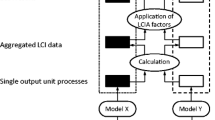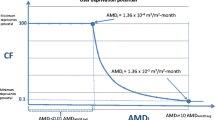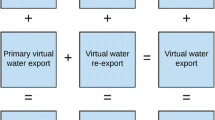Abstract
Planning appropriate portfolios of new water supplies and demand management measures requires considering a wide array of options and their interactions over a largely unknown future. Various modelling-assisted approaches are available to help this planning process. This paper applies two such frameworks to the UK’s Thames water resource system and compares their methods and outputs: how they consider uncertainty, how they represent supply and demand management options, and what plans each recommends. The first method is the current England and Wales industry standard: annual least-cost capacity expansion optimisation over a 25 to 30 year time horizon considering capital, operating (fixed and variable), social and environmental costs. The second approach uses stochastic simulation and regret analysis to select a preferred alternative, then statistical cluster analysis to identify causes of system failure enabling further plan improvement. When applied iteratively with system planners this second approach is referred to as Robust Decision Making (RDM). The economic optimisation approach considers all plausible combinations of supply and conservation schemes and recommends the least-cost schedule of their implementation. Our RDM application considers a smaller number of options but makes a more detailed assessment of the effect of uncertainty (supply, demand and energy price uncertainty were considered) on multiple criteria of system performance. The simulation-based approach also enables more realistic interaction amongst supply and demand management schemes. Both approaches recommended different plans which we explain by discussing the benefits and limitations of each. Joint application is recommended to produce least-cost plans that are robust considering multiple criteria of performance across a wide range of futures.









Similar content being viewed by others
References
Arena C, Mazzola MR, Scordo G (2010) A simulation/optimization model for selecting infrastructure alternatives in complex water resource systems. Water Sci Technol 61(12):3050–3060. doi:10.2166/wst.2010.220
Ben-Haim Y (2006) Information gap decision theory: Decisions under severe uncertainty, 2nd edn. Academic Press, New York
Braga BPF, Conejo JGL, Becker L, Yeh WWG (1985) Capacity Expansion of Sao-Paulo water-supply. J Water Res Plan Manag Asce 111(2):238–252
Brill ED, Flach JM, Hopkins LD, Ranjithan S (1990) MGA - A decision support system for complex, incompletely defined problems. IEEE Trans Syst Man Cybern 20(4):745–757. doi:10.1109/21.105076
Bryant BP, Lempert RJ (2010) Thinking inside the box: a participatory, computer-assisted approach to scenario discovery. Technol Forecast Soc Chang 77(1):34–49
Cookson A, Weston A (2008) Thames Water Modelling project: Model 1a final report. Environment Agency
Dandy GC, McBean EA, Hutchinson BG (1984) A model for contrained optimum water pricing and capacity expansion. Water Resour Res 20(5):511–520
Dessai S, Hulme M (2007) Assessing the robustness of adaptation decisions to climate change uncertainties: a case study on water resources management in the East of England. Glob Environ Chang Hum Policy Dimens 17(1):59–72. doi:10.1016/j.gloenvcha.2006.11.005
EA (2008) Water Resource Planning Guidelines. Environment Agency. Almondsbury, UK
Essex and Suffolk Water (2010) Final water resources management plan 2010–2035. Durham, England
Eurostat (2011) Electricity prices for industrial consumers. Eurostat. Available via Eurostat. http://epp.eurostat.ec.europa.eu/tgm/table.do?tab=table&init=1&plugin=1&language=en&pcode=ten00114. Accessed February 6, 2011
Fredrich AJ (1975) Hydrologic engineering methods for water resources development (trans: Hydrologic Engineering Center). Reservoir yield, vol 8. Davis, California
Friedman JH, Fisher NI (1999) Bump hunting in high-dimensional data. Stat Comput 9(2):123–143
Griffin R (2006) Water resource economics: The analysis of scarcity, policies, and projects. MIT Press, Cambridge
Groves DG, Lempert RJ (2007) A new analytic method for finding policy-relevant scenarios. Glob Environ Chang Hum Policy Dimens 17(1):73–85. doi:10.1016/j.gloenvcha.2006.11.006
Hall JW, Lempert RJ, Keller K, Hackbarth A, Chirstophe M, McInerney DJ (2011a) Robust climate policies under uncertainty: A comparison of Robust Decision-Making and Info-Gap methods. Risk Analysis
Hall JW, Watts G, Keil M, de Vial L, Street R, Conlan K, O'Connell PE, Beven KJ, Kilsby CG (2011b) Towards risk-based water resources planning in England and Wales under a changing climate. Water and Environment Journal:no-no. doi:10.1111/j.1747-6593.2011.00271.x
Hashimoto T, Stedinger JR, Loucks DP (1982) Reliability, resiliency, and vulnerability criteria for water resource system performance evaluation. Water Resour Res 18(1):14–20
Herrington P (2007) Waste Not, Want Not? Water Tariffs for Sustainability. WWF, Bristol
Kiritskiy SN, Menkel MF (1952) Water Management Computations (in Russian). GIMIZ, Leningrad, USSR
Klemeš V (1969) Reliability estimates for a storage reservoir with seasonal input. J Hydrol 7(2):198–216
Knight FH (1921) Risk, Uncertainty, and Profit. Houghton Mifflin, Boston
Lempert RJ, Collins MT (2007) Managing the risk of uncertain threshold responses: comparison of robust, optimum, and precautionary approaches. Risk Anal 27(4):1009–1026. doi:10.1111/j.1539-6924.2007.00940.x
Lempert RJ, Groves DG (2010) Identifying and evaluating robust adaptive policy responses to climate change for water management agencies in the American west. Technol Forecast Soc Chang 77(6):960–974. doi:10.1016/j.techfore.2010.04.007
Lempert RJ, Groves DG, Popper SW, Bankes SC (2006) A general, analytic method for generating robust strategies and narrative scenarios. Manag Sci 52(4):514–528. doi:10.1287/mnsc.1050.0472
Lopez A, Fung F, New M, Watts G, Weston A, Wilby RL (2009) From climate model ensembles to climate change impacts and adaptation: a case study of water resource management in the southwest of England. Water Resour Res 45. doi:10.1029/2008wr007499
Loucks DP, van Beek E (2006) Water Resources Systems Planning and Management—An Introduction to Methods, Models and Applications. UNESCO, Paris
Loucks DP, Stedinger JR, Haith DA (1981) Water resources systems planning and analysis. Prentice-Hal, Englewood Cliffs
Luo B, Maqsood I, Huang GH (2007) Planning water resources systems with interval stochastic dynamic programming. Water Resour Manag 21(6):997–1014. doi:10.1007/s11269-006-9069-4
Luss H (1982) Operations-research and capacity expansion problems—a survey. Oper Res 30(5):907–947
Maass A, Hufschmidt M, Dorfman R, Thomas H, Marglin S, Fair G (1962) Design of Water-Resources Systems. Harvard University Press, Cambridge
Mahmoud MR (2006) High dimension dynamic programming model for water resources expansion projects. Eng Optimiz 38(3):371–389. doi:10.1080/03052150600593218
Manne AS (1967) Investments for Capacity Expansion: Size, Location, and time-Phasing. MIT Press, Boston
Martin QW (1987) Hierarchical algorithm for water-supply expansion. J Water Res Plan Manag Asce 113(5):677–695
Matrosov ES, Harou JJ, Loucks DP (2011) A computationally efficient open-source water resource system simulation model: IRAS-2010—Application to London and the Thames Basin. Environ Model Softw. doi:10.1016
Mays LW (2005) Water Resources Systems Management Tools. McGraw-Hill, New York
Murphy JM, Sexton DMH, Jenkins GJ, Boorman PM, Booth BBB, Brown CC, Clark RT, Collins M, Harris GR, Kendon EJ, Betts RA, Brown SJ, Howard TP, Humphrey KA, McCarthy MP, McDonald RE, Stephens A, Wallace C, Warren R, Wilby R, Wood RA (2009) UK Climate Projections Science Report: Climate change projections. Met Office, Exeter
Olaoghaire, Himmelblau (1974) Optimal Expansion of a water resources systems
Padula S, Harou JJ, Papageorgiou LG, Viros V (2010) Formulation and application of a minimum cost capacity expansion model for water supply and demand systems. In: BHS Third International Symposium, Newcastle, UK, 2010. British Hydrological Society
Rogers PP, Fiering MB (1986) Use of systems-analysis in water management. Water Resour Res 22(9):S146–S158. doi:10.1029/WR022i09Sp0146S
Ryan S, McCalley J, Woodruff D (2011) Long term resource planning for electric power systems under uncertainty, Technical Report. Iowa State University
Sahinidis NV (2004) Optimization under uncertainty: state-of-the-art and opportunities. Comput Chem Eng 28(6–7):971–983
Savage LJ (1954) The Foundation of Statistics. Dover Publications
Simon H (1959) Theories of decision-making in economic and behavioral science. Am Econ Rev 49(3):253–283
Sutton & East Surrey Water (2009) Draft water resources management plan
Thames Water (2009) Revised Water Resource Management Plan
Three Valleys (2008) Revised Draft Water Resource Management Plan. UK
UKWIR (2002) The Economic of Balancing Supply & Demand (EBSD)—Main Report. London
UKWIR (2009) Assessment of the Significance to Water Resource Management Plans of the UK Climate change projections 2009
Veolia Water Central Limited (2010) Water Resources Management Plan. Hatfield, UK
Veolia Water Central Limited (2011) Charges Scheme 2011/2012
von Lany PH, Choudhury F, Hepworth N, Akande K (this issue) Applying optimisation and uncertainty analysis to help develop an integrated water resources plan for South East England. Water Resources Management
Acknowledgments
The authors thank Steven Wade and Brigitte von Christierson from HR Wallingford who provided the climate change perturbation ratios. Evgenii Matrosov and Julien Harou were supported by the ARCC-Water project funded by EPSRC (EP/G061181/1) and Silvia Padula was funded by the UCL Faculty of Engineering. The authors thank 3 reviewers whose comments strongly improved the paper.
Author information
Authors and Affiliations
Corresponding author
Additional information
Evgenii S. Matrosov and Silvia Padula contributed equally to this article.
Rights and permissions
About this article
Cite this article
Matrosov, E.S., Padula, S. & Harou, J.J. Selecting Portfolios of Water Supply and Demand Management Strategies Under Uncertainty—Contrasting Economic Optimisation and ‘Robust Decision Making’ Approaches. Water Resour Manage 27, 1123–1148 (2013). https://doi.org/10.1007/s11269-012-0118-x
Received:
Accepted:
Published:
Issue Date:
DOI: https://doi.org/10.1007/s11269-012-0118-x




